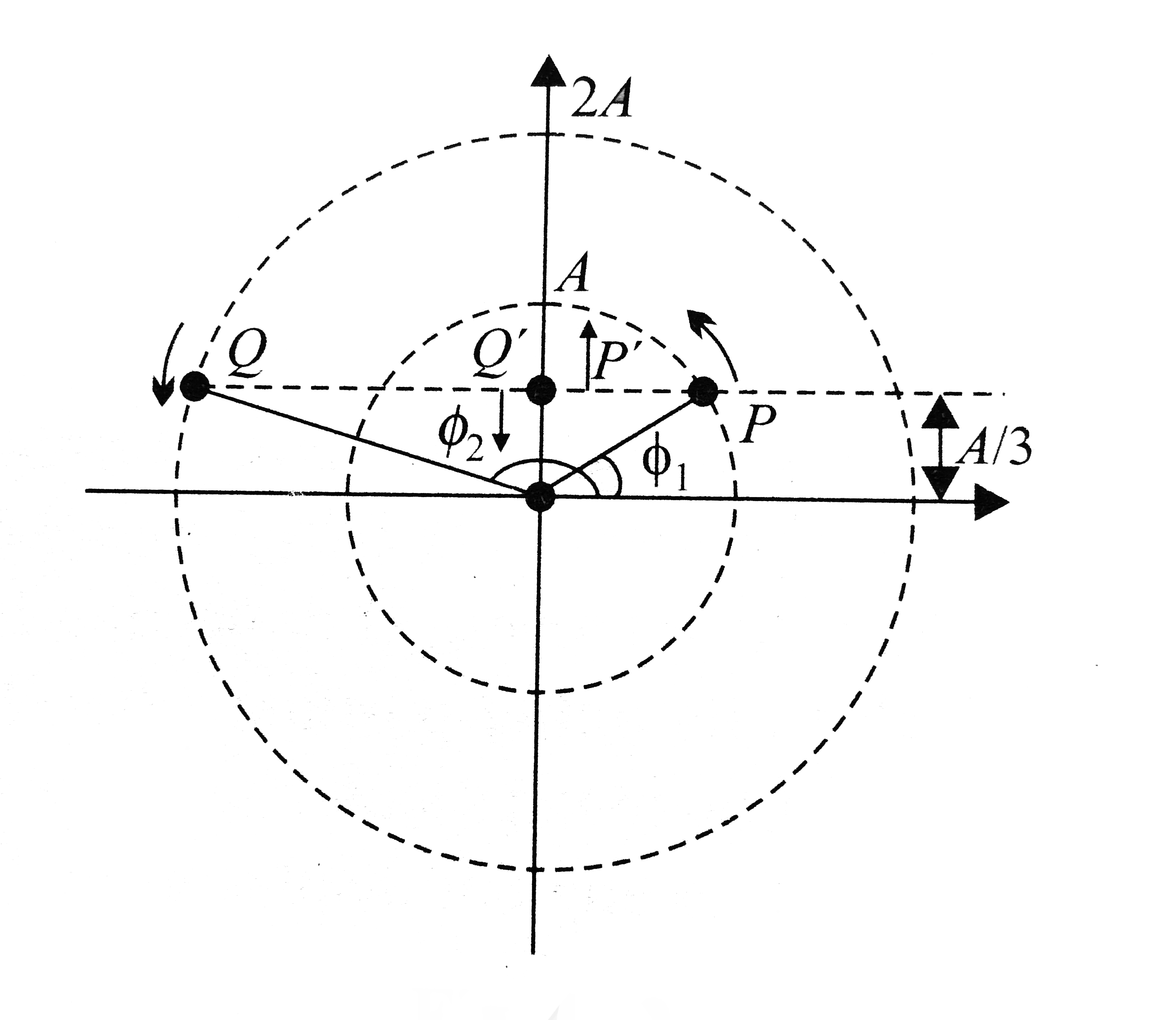two particle executing SHM with same frequency and amplitudes Aand2A on same straight line with same mean position cross each other in opposite direction at a distance A/3 from mean position. Find the phase difference in the two SHM s.
Show the two corresponding particals circular motion for the two mentioned particals in SHM. Let particals P be going up and partical Q be going down. From the figure show the repesctive phase difference of partical p and q are
ϕ1=sin−1(13) [phase angle of P]
and ϕ2=π−sin−1(16) [phase angle of Q]
Thus phase difference in the two SHMs is
Δϕ=ϕ2−ϕ1=π−sin−1(16)−sin−1(13)

Topper's Solved these Questions
- BOOK - CENGAGE PHYSICSCHAPTER - LINEAR AND ANGULAR SIMPLE HARMONIC MOTIONEXERCISE - Solved Example15videos
LINEAR AND ANGULAR SIMPLE HARMONIC MOTION
- BOOK - CENGAGE PHYSICSCHAPTER - LINEAR AND ANGULAR SIMPLE HARMONIC MOTIONEXERCISE - Exercise 4.123videos
LINEAR AND ANGULAR SIMPLE HARMONIC MOTION
- BOOK - CENGAGE PHYSICSCHAPTER - KINETIC THEORY OF GASES AND FIRST LAW OF THERMODYNAMICSEXERCISE - Interger11videos
KINETIC THEORY OF GASES AND FIRST LAW OF THERMODYNAMICS
- BOOK - CENGAGE PHYSICSCHAPTER - MISCELLANEOUS KINEMATICSEXERCISE - Interger type3videos
MISCELLANEOUS KINEMATICS
Similar Questions
two particle executing SHM with same frequency and amplitudes Aand2A on same straight line with same mean position cross each other in opposite direction at a distance A/3 from mean position. Find the phase difference in the two SHM s.
View SolutionA partical excutes SHM with same frequency and amplitude along the same straight line. They cross each other , at a point midway between the mean and the exterme position. Find the Phase difference between them.
View Solution
Knowledge Check
- Question 1 - Select One
Two particles are in SHM with same angular frequency and amplitudes A and 2A respectively along same straight line with same mean position. They cross each other at postion A/2 distance from mean position in opposite direction. The phase between them is-
A5π6−sin−1(14)Bπ6−sin−1(14)C5π6−cos−1(14)Dπ6−cos−1(14) - Question 2 - Select One
Two particles execute S.H.M. along the same line at the same frequency. They move in opposite direction at the mean position. The phase difference will be :
A2πB2π/3CπDπ/2 - Question 3 - Select One
Two particles execute SHM of the same time period along the same straight lines. They cross each other at the mean position while going in opposite directions. Their phase difference is
Aπ2BπC3π2D2π
The maximum seperation between two particles executing simple harmonic motion of the equal amplitude and same frequency along the same straight line and about the same mean position, is √3 times the amplitude of oscillation. IF the phase difference between them is ϕ, determine 2π/ϕ.
View SolutionTwo particles execute SHM of same amplitude and frequency on parallel lines. They pass one another when moving in opposite directions each time their displacement is one thhird their amplitude. What is the phase difference between them?
View SolutionTwo particles executes S.H.M. of the same amplitude and frequency along the same straight line. They pass one another when going in opposite directions, each time their displacement is root three by two times amplitude. The phase difference between them is
View SolutionThe phase difference between two particle executing SHM of the same amplitude and frequency along same straight line while pessing one another when going in apposition direction with equal displacement from then respectively straing about is is 2π/3 if the prass if one particle is π/6 find the displecement at this instant amplitude is A
View SolutionTwo particles execute SHM of same amplitude and same time period, about same mean position but with a phase difference between them. At an instant they are found to cross each other at x=+A3. The phase difference between them is
View Solution

